
 |
||||
|
Carl Heinrich Trautsch and Johanna Christina Hoelzer were both born in the kingdom of Prussia in the early 1830’s. The specific hometown or region of their birth is not known. (Prussia, the largest state of the German Confederation, at that time comprised much of the northern part of present-day Germany and Poland.)
In 1853, when Heinrich was just 22 years old and Christina about 20, they brought their baby daughter Louise to Wisconsin and settled on a ridge of gently rolling hills above the Wisconsin River. Heinrich’s older brother may have immigrated with them: a Friedrich Trautsch — Heinrich’s senior by 10 years — was residing with his wife in the same township by 1856. Whether the two families arrived in tandem or whether one brother preceded the other is not known. As homesteaders, Heinrich and Christina began the daunting task of carving a farm out of virgin forest. They had to fell trees, build cabins and barns, clear the land and plant crops, and raise animals for food and sustenance. Heinrich was hungry for land. Tract by tract, he began to acquire 80-acre and 40-acre parcels of land from the U.S. Land Office. (Under the Public Land Act of 1820, the U.S. government sold “public” land — i.e., land taken from Native American tribes — to settlers for $1.25 an acre.) He also bought acreage from a neighboring farmer. By 1862 he and Christina owned 380 acres of prime farmland. Their farmland was located seven miles from the town of Wauzeka (on the Wisconsin River) and eleven miles from Prairie du Chien, a larger port at the confluence of the Mississippi and Wisconsin Rivers. The little family grew. Karolina (Lena) was born in 1856 and Christian Heinrich (Henry) in 1859. But the Trautsch household was not a tranquil place. By Louise’s later account, her father had a violent temper. He drove his young wife, and later his children, mercilessly. His abuse added to the difficulties Christina experienced in her life as a settler. Cut off from her family and the culture she knew, frightened, isolated, and overworked, she sank into despair. It is even possible that she succumbed to an extreme form of depression marked by erratic behavior that was very common among women in her situation (so common, in fact that scholars have theorized it was due to a diet high in salt pork, fried beef, eggs, milk, and butter). After six years of hardship, misery, and abuse, Christina resolved to flee with her two youngest children, leaving Louise to her fate. But when the time came, she could not bring herself to abandon her oldest daughter, nor could she conceive of how to leave with three children in tow. So she stayed on in her unhappy situation. In 1860 Heinrich’s younger sister Ernestine and her husband Christian Walter arrived from Prussia and purchased land adjoining the Trautsch farm. Other families from Germany settled in the area, which became known as the “German (Deutsch) Ridge” (“Dutch Ridge” today). Christina continued to bear children: Emma in 1862, Mary in 1865, Herman in 1867, and Friedrich Martin Emil in 1869. As the Trautsch children grew, Heinrich put them to work on the farm. They all worked hard, but none harder than Louise, whom the neighbors referred to as “Trautsch’s hired man.” By 1866, the immigrants on the German Ridge had begun to meet for church services as the “country congregation” of the Lutheran church in Prairie du Chien. The Heinrich and Friedrich Trautsch families and the Christian Walter family attended regularly. Their children were baptized, confirmed, and in some cases buried, on the ridge — many by Emil Wiederaenders, who took up his pastoral duties there in 1868. In that same year, Christina and Heinrich lost their year-old son Herman. A year later Mary died at age four. And in August of 1870, Christina herself succumbed to typhoid fever. She was buried next to her two children in the little cemetery across the road from the Trautsch farm. Heinrich, a widower at 39, was left with their five surviving children: Louise (age 17), Lena (14), Henry (11), Emma (8), and baby Emil (18 months). Heinrich married Emilie Prochnow Köpp, a widow with three teenaged children, the following spring (1871). The Trautsch household now contained eight children. Louise soon decided to go to Prairie du Chien to work as a domestic servant. Early in 1872, little Friedrich Emil died at the age of three. Two children, Edward and Pauline, were soon born to Heinrich and Emilie. Meanwhile the older children began to leave the nest to marry or make their own way in life. Louise Trautsch married Edward Wiederanders in 1872. Her sister Lena married Theodore Mohr, a farm boy from the German Ridge, in 1881. They moved to Milwaukee and opened a tavern with the help of Theodore’s younger brother Erwin. In 1902 Emma Trautsch married Erwin, and the two couples lived and worked together, with Lena and Emma cooking for their patrons while the men kept the saloon. Both couples remained childless. Henry Trautsch married a local girl and bought a farm in Seneca, about 10 miles away. Heinrich retired from farming at age 64. He deeded his farm to his son Edward in 1895 on the condition that Edward deliver one third of the crops and stock to his parents every year, bear all the costs of operation except the taxes, and allow his parents to reside in the house for the rest of their lives. Just two years later Emilie died at age 63. Heinrich, once again a widower, lived on with Edward’s family for 25 years, outliving even his son by two years. In 1922 the old man suffered a stroke and died at the age of 91. © Julia Moore, 2007. All rights reserved. Sources: Eleonore (Ella) Wiederanders Hay’s family history and memoir, written ca. 1968. U.S. and Wisconsin Census Records, 1870-1910. Parish records of St. Peter’s Lutheran Church, Prairie du Chien. Seasons of Change, Celebrating The 125th Anniversary of St. Peter’s Lutheran Church, Prairie du Chien, 1986. Land records from the U.S. Land Office and Dawson County, Wisconsin. Luchetti, Cathy, and Olwell, Carol, Women of the West, W.W. Norton & Co., 2001 |
Click on pictures to enlarge
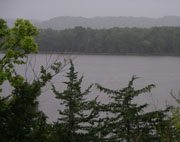 The Wisconsin River near Wauzeka, Wisconsin 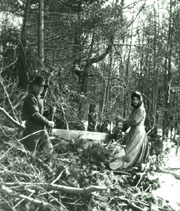 Man and woman clearing land in Wisconsin 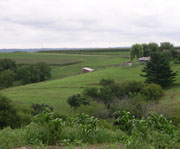 A present day farm on the German Ridge 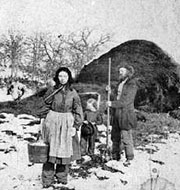 A pioneer family on their farm in Wisconsin 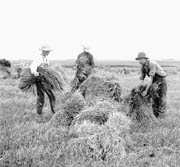 “Shocking,” or bundling, the grain as it is harvested 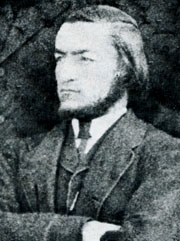 Emil Wiederaenders, minister to the families on the German Ridge 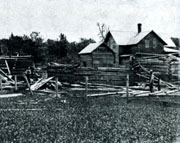 Log buildings under construction in Praire du Chien 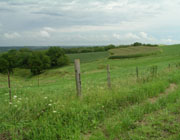 Heinrich Trautsch’s farmland on the German Ridge |
|||